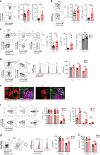Inhibition of glucose metabolism selectively targets autoreactive follicular helper T cells
- PMID: 30348969
- PMCID: PMC6197193
- DOI: 10.1038/s41467-018-06686-0
Inhibition of glucose metabolism selectively targets autoreactive follicular helper T cells
Abstract
Follicular helper T (TFH) cells are expanded in systemic lupus erythematosus, where they are required to produce high affinity autoantibodies. Eliminating TFH cells would, however compromise the production of protective antibodies against viral and bacterial pathogens. Here we show that inhibiting glucose metabolism results in a drastic reduction of the frequency and number of TFH cells in lupus-prone mice. However, this inhibition has little effect on the production of T-cell-dependent antibodies following immunization with an exogenous antigen or on the frequency of virus-specific TFH cells induced by infection with influenza. In contrast, glutaminolysis inhibition reduces both immunization-induced and autoimmune TFH cells and humoral responses. Solute transporter gene signature suggests different glucose and amino acid fluxes between autoimmune TFH cells and exogenous antigen-specific TFH cells. Thus, blocking glucose metabolism may provide an effective therapeutic approach to treat systemic autoimmunity by eliminating autoreactive TFH cells while preserving protective immunity against pathogens.
Conflict of interest statement
The authors declare no competing interests.
Figures








Comment in
-
Targeting autoimmune-specific metabolic processes.Nat Rev Rheumatol. 2018 Dec;14(12):686. doi: 10.1038/s41584-018-0126-1. Nat Rev Rheumatol. 2018. PMID: 30420748 No abstract available.
References
-
- Daikh DI, Finck BK, Linsley PS, Hollenbaugh D, Wofsy D. Long-term inhibition of murine lupus by brief simultaneous blockade of the B7/CD28 and CD40/gp39 costimulation pathways. J. Immunol. 1997;159:3104–3108. - PubMed
Publication types
MeSH terms
Substances
Grants and funding
LinkOut - more resources
Full Text Sources
Molecular Biology Databases
Miscellaneous

